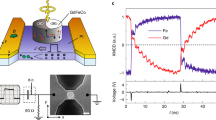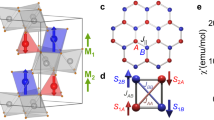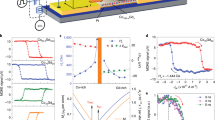Abstract
The prospect of controlling the magnetization (M) of a material solely with an external electric field (E) could enable the development of low-power spintronics. Although there has been some success towards this end, most approaches involve controlling interactions at the interface between two different materials rather than switching of a single bulk phase. Here we report the ability to exert complete control over the generation and reversal of the bulk spontaneous M of the single-component multiferroics RFeO3 (R = Dy0.70Tb0.30, Dy0.75Gd0.25) with an E alone. We achieve this by controlling the anisotropic character of rare-earth magnetism and exploiting the competition between different magnetoelectric phases. We also show that whether M is reversed or retained on the E-induced polarization reversal depends on the E modulation speed. This is ascribed to the different dynamical characteristics of ferroelectric and multiferroic domain walls governed by the reversal dynamics of rare-earth moments and iron spins, respectively.
This is a preview of subscription content, access via your institution
Access options
Subscribe to this journal
Receive 12 print issues and online access
$209.00 per year
only $17.42 per issue
Buy this article
- Purchase on Springer Link
- Instant access to full article PDF
Prices may be subject to local taxes which are calculated during checkout






Similar content being viewed by others
References
Katine, J. A., Albert, F. J., Buhrman, R. A., Myers, E. B. & Ralph, D. C. Current-driven magnetization reversal and spin-wave excitations in Co/Cu/Co Pillars. Phys. Rev. Lett. 84, 3149–3152 (2000).
Chappert, C., Fert, A. & Dau, F. N. V. The emergence of spin electronics in data storage. Nature Mater. 6, 813–823 (2007).
Fiebig, M. Revival of the magnetoelectric effect. J. Phys. D 38, R123–R152 (2005).
Cheong, S-W. & Mostovoy, M. Multiferroics: A magnetic twist for ferroelectricity. Nature Mater. 6, 13–20 (2007).
Ramesh, R. & Spaldin, N. A. Multiferroics: Progress and prospects in thin films. Nature Mater. 6, 21–29 (2007).
Tokura, Y. Multiferroics-toward strong coupling between magnetism and polarization in a solid. J. Magn. Magn. Matter 310, 1145–1150 (2007).
Kleemann, W. Switching magnetism with electric fields. Physics 2, 105 (2009).
Tokura, Y. & Seki, S. Multiferroics with spiral spin orders. Adv. Mater. 22, 1554–1565 (2010).
Kita, E., Tasaki, A. & Siratori, K. Application of SQUID magnetometer to the measurement of magnetoelectric effect in Cr2O3 . Jpn. J. Appl. Phys. 18, 1361–1366 (1979).
Ohno, H. et al. Electric-field control of ferromagnetism. Nature 408, 944–946 (2000).
Yamada, Y. et al. Electrically induced ferromagnetism at room temperature in cobalt-doped titanium dioxide. Science 332, 1065–1067 (2011).
Chiba, D. et al. Magnetization vector manipulation by electric fields. Nature 455, 515–518 (2009).
Weisheit, M. et al. Electric field-induced modification of magnetism in thin-film ferromagnets. Science 19, 349–351 (2007).
Wang, Y., Hu, J., Lin, Y. & Nan, C-W. Multiferroic magnetoelectric composite nanostructures. NPG Asia Mater. 2, 61–68 (2010).
Sahoo, S. et al. Ferroelectric control of magnetism in BaTiO3/Fe heterostructures via interface strain coupling. Phys. Rev. B 76, 092108 (2007).
Geprägs, S., Brandlmaier, A., Opel, M., Gross, R. & Goennenwein, S. T. B. Electric field controlled manipulation of the magnetization in Ni/BaTiO3 hybrid structures. Appl. Phys. Lett. 96, 142509 (2010).
Chen, X., Hochstrat, A., Borisov, P. & Kleemann, W. Magnetoelectric exchange bias systems in spintronics. Appl. Phys. Lett. 89, 202508 (2006).
He, X. et al. Robust isothermal electric control of exchange bias at room temperature. Nature Mater. 9, 579–585 (2010).
Chu, Y-H. et al. Electric-field control of local ferromagnetism using a magnetoelectric multiferroic. Nature Mater. 7, 478–482 (2008).
Lebeugle, D., Mougin, A., Viret, M., Colson, D. & Ranno, D. Electric field switching of the magnetic anisotropy of a ferromagnetic layer exchange coupled to the multiferroic compound BiFeO3 . Phys. Rev. Lett. 103, 257601 (2009).
Heron, J. T. et al. Electric-field-induced magnetization reversal in a ferromagnet–multiferroic heterostructure. Phys. Rev. Lett. 107, 217202 (2011).
Ascher, E., Rieder, H., Schmid, H. & Stössel, H. Some properties of ferromagnetoelectric nickel–iodine boracite, Ni3B7O13I. J. Appl. Phys. 37, 1404–1405 (1966).
Murakawa, H., Onose, Y., Miyahara, S., Furukawa, N. & Tokura, Y. Ferroelectricity induced by spin-dependent metal-ligand hybridization in Ba2CoGe2O7 . Phys. Rev. Lett. 105, 137202 (2010).
Saito, M., Ishikawa, K., Konno, S., Taniguchi, K. & Arima, T. Periodic rotation of magnetization in a non-centrosymmetric soft magnet induced by an electric field. Nature Mater. 8, 634–638 (2009).
Lottermoser, T. et al. Magnetic phase control by an electric field. Nature 430, 541–544 (2004).
Choi, Y. J., Zhang, C. L., Lee, N. & Cheong, S-W. Cross-control of magnetization and polarization by electric and magnetic fields with competing multiferroic and weak-ferromagnetic phases. Phys. Rev. Lett. 105, 097201 (2010).
Chun, S. H. et al. Electric field control of nonvolatile four-state magnetization at room temperature. Phys. Rev. Lett. 108, 177201 (2012).
Logginov, A. S., Meshkov, G. A., Nikolaev, A. V. & Pyatakov, A. P. Magnetoelectric control of domain walls in a ferrite garnet film. JETP Lett. 86, 115–118 (2007).
Logginov, A. S. et al. Room temperature magnetoelectric control of micromagnetic structure in iron garnet films. Appl. Phys. Lett. 93, 182510 (2008).
Dzyaloshinskii, I. A thermodynamic theory of weak ferromagnetism of antiferromagnetics. J. Phys. Chem. Solids 4, 241–255 (1958).
Moriya, T. Anisotropic superexchange interaction and weak ferromagnetism. Phys. Rev. 120, 91–98 (1960).
Fennie, C. J. Ferroelectrically induced weak ferromagnetism by design. Phys. Rev. Lett. 100, 167203 (2008).
Benedek, N. A. & Fennie, C. J. Hybrid improper ferroelectricity: A mechanism for controllable polarization–magnetization coupling. Phys. Rev. Lett. 106, 107204 (2011).
Yamaguchi, T. & Tsushima, K. Magnetic symmetry of rare-earth orthochromites and orthoferrites. Phys. Rev. B 8, 5187–5198 (1973).
Zvezdin, A. K. & Mukhin, A. A. Magnetoelectric interactions and phase transitions in a new class of multiferroics with improper electric polarization. JETP Lett. 88, 505–510 (2008).
Tokunaga, Y. et al. Composite domain walls in a multiferroic perovskite ferrite. Nature Mater. 8, 558–562 (2009).
Bertaut, E. F. in Magnetism Vol. 3 (eds Rado, G. T. & Suhl, H) 149–209 (Academic, 1963).
Tokunaga, Y., Iguchi, S., Arima, T. & Tokura, Y. Magnetic-field-induced ferroelectric state in DyFeO3 . Phys. Rev. Lett 101, 097205 (2008).
Bertaut, E. F., Chappert, J., Mareschal, J., Rebouillat, J. P. & Sivardière, J. Structures magnetiques de TbFeO3 . Solid. State Commun. 5, 293–298 (1967).
Bourée, J. E. & Hammann, J. Mise en évidence expérimentale des effects de forme dans l’orthoferrite de terbium. J. Phys. 36, 391–397 (1975).
Acknowledgements
The authors thank N. Furukawa, S. Miyahara, H. Sakai and D. Okuyama for fruitful discussions. This work was supported in part by Grants-in-Aid for Scientific Research from the MEXT, Japan and Funding Program for World Leading Innovative R&D on Science and Technology (FIRST) on ‘Quantum Science on Strong Correlation’ from JSPS.
Author information
Authors and Affiliations
Contributions
The experiments were performed by Y. Tokunaga. The results were discussed and interpreted by Y. Tokunaga, Y. Taguchi, T-h.A. and Y. Tokura.
Corresponding author
Ethics declarations
Competing interests
The authors declare no competing financial interests.
Rights and permissions
About this article
Cite this article
Tokunaga, Y., Taguchi, Y., Arima, Th. et al. Electric-field-induced generation and reversal of ferromagnetic moment in ferrites. Nature Phys 8, 838–844 (2012). https://doi.org/10.1038/nphys2405
Received:
Accepted:
Published:
Issue Date:
DOI: https://doi.org/10.1038/nphys2405
This article is cited by
-
Impact of Tb substitution on structural, electrical and magnetic properties of Ho1−xTbxFeO3 orthoferrite
Applied Physics A (2024)
-
Domain-wall magnetoelectric coupling in multiferroic hexagonal YbFeO3 films
Scientific Reports (2023)
-
Out-of-plane polarization reversal and changes in in-plane ferroelectric and ferromagnetic domains of multiferroic BiFe0.9Co0.1O3 thin films by water printing
Scientific Reports (2023)
-
Electric-field control of topological spin textures in BiFeO3/La0.67Sr0.33MnO3 heterostructure at room temperature
Rare Metals (2023)
-
Topologically protected magnetoelectric switching in a multiferroic
Nature (2022)



